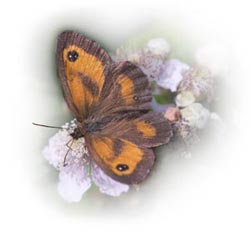
Beautiful Gardens ... Buzzing with Wildlife


Wildlife Gardening at No 1
Our garden, in the north Norfolk village of Edgefield, is a country garden. Although bordered by gardens on either side the far end backs onto a small arable field which is surrounded by high hedges. The soil is light, full of small stones and flints and in some parts pure sand as befits its position on the edge of the Holt-Cromer Ridge, a glacial material dating from one of the last ice ages. One of the highest parts of Nofolk our garden is a mere 80 meters above sea level and surrounded by small valleys that drain into the River Glaven.
For my own interest as much as anything I have decided to catalogue on-line, the wildlife of the garden. We have lived here for 15 years and always gardened organically and kept records of the wildlife that we share our space with. When we arrived the garden was unkempt, and mostly an overgrown vegetable plot. Having needed space for three goats in the past, we now share it with our daughter, a small dog and a few chickens and encourage the wild in at all times (maybe not ground elder-although I do enjoy it's flowers, bindweed - again the flowers brighten up many a shrub in late summer or couch grass - which does tend to appear amongst all my favourite flowers).
More of the garden later, here follows the list as at February 10 2010.
Mammals
Red deer - seen once moving across the field at the back one snowy winter.
Hedgehog - seen occasionally at least once a year.
Mole - signs of mole activity appear in the garden each year. I swear and curse but couldn't bare to do more than say 'go away' moles.
Pipistrelle Bat - seen in two or threes every summer and eat all my moths whenever I put out the trap.
Grey Squirrel - amazingly only once, not a regular visitor.
Brown Rat - not encouraged but visit periodically never-the-less.
Wood Mouse - many of these, especially in our shed.
Bank Vole - many of these, common also in the shed and not surprisingly in the raised bank.
Rabbit - common before the new boundary hedge grew up, now not seen.
Brown Hare -twice seen running up the garden from top to bottom.
Birds
Grey Heron
Mute Swan
Pink-footed Goose
Greylag Goose
Egyptian Goose
Mallard
Sparrowhawk
Buzzard (new in 2009, they are becoming more numerous in North Norfolk)
Kestrel
Hobby
Red-legged Partridge
Quail (heard only)
Pheasant
Moorhen
Woodcock
Greenshank (heard only)
Oystercatcher
Lapwing
Black-headed Gull
Common Gull
Herring Gull
Lesser Black-backed Gull
Woodpigeon
Stock Dove
Collared Dove
Turtle Dove
Cuckoo
Barn Owl
Little Owl
Tawny Owl
Swift
Green Woodpecker (heard only)
Great Spotted Woodpecker
Skylark
Swallow
House Martin
Pied Wagtail
Grey Wagtail
Yellow Wagtail
Wren
Dunnock
Robin
Common Redstart
Blackbird
Fieldfare
Song Thrush
Redwing
Mistle Thrush
Lesser Whitethroat
Blackcap
Chiffchaff
Spotted Flycatcher
Goldcrest
Long-tailed Tit
Blue Tit
Great Tit
Coal Tit
Jackdaw
Rook
Carrion Crow
Magpie
Jay
Starling
House Sparrow
Chaffinch
Brambling
Greenfinch
Goldfinch
Siskin
Redpoll
Yellowhammer
Reptiles - so far we have drawn a blank. We know there are slowworms but have yet to find one in the garden
Amphibians
Common Frog
Common Toad
Smooth Newt
Fish
Sticklebacks that have appeared in our ponds. Didn't particularly want them
Insects
Mayflies
Dragonflies and damselflies
Large Red Damselfly
Blue-taled Damselfly
Azure Damselfly
Banded Demoiselle
Southern Hawker
Migrant Hawker
Common Darter
Ruddy Darter
Grasshoppers and crickets
Field Grasshopper
Oak Bush Cricket
Dark Bush Cricket
Earwigs
Bugs
Hawthorn Shield Bug
Common Pond Skater
Common Backswimmer
Butterflies
Small White
Green-veined White
Large White
Orange Tip
Clouded yellow
Brimstone
Peacock
Comma
Painted Lady
Red Admiral
Small Tortoiseshell
Grayling
Ringlet
Gatekeeper
Speckled Wood
Meadow Brown
Wall Brown
Green Hairstreak
Small Copper
Common Blue
Holly Blue
White Admiral (new in 2009)
Small Skipper
Large Skipper
Essex Skipper
Moths
Over 350 macro moths have been recorded so far. See garden moth list for complete list and photographs.
Flies
Dasineura crataegi Midge gall. Rosette gall on terminal shoot of Hawthorn
Dasineura odoratae Thickened, rolled leaf margins of Sweet Violet
Bibio marci St Mark's-fly
Bombylius major Common Bee-fly
Hoverflies
Episyrphus balteatus
Melanostoma scalare
Volucella bombylans
Volucella bombylans
Eristalis tenax Drone-fly
Syrphus vitripennis
Meliscaeva auricollis
Sawflies
Pontania vesicator Bean gall on leaf of Crack Willow
Gall wasps
Andricus kollari Marble galls on oak
Andricus quercuscorticus. Truffle gall on sapling of Oak
Cynips divisa Thick walled pea gall
Neuroterus quercusbaccarum Common Spangle Gall
Neuroterus numismalis 'Silk button gall.
Diplolepis rosae Wasp Robin's pincushion on roses
Phanacis hypochoeridis Wasp. Swelling on stem of Cat'sear
Ichneumons
Rhyssa persuasoria
Ophion luteus
Netalia testaceus
Ants
Lasius niger Black Garden Ant
Wasps
Vespula vulgaris Common Wasp
Vespa crabro Hornet
Bees
Megachile centuncularis Leaf-cutter Bee roses
Andrena haemorrhoa Solitary mining bee on cowslips
Osmia rufa Red mason bee
Anthophora plumipes Bumblebee mimic lungworts
Bombus hortorum
Bombus lucorum
Bombus terrestris
Bombus pratorum
Bombus pascuorum
Bombus lapidarius
Bombus vestalis Cuckoo bee
Bombus rupestris Cuckoo bee
Beetles
Carabus violaceus Violet Ground Beetle
Carabus nemoralis
Nicrophorus humator
Nicrophorus investigator
Oiceoptoma thoracicum
Staphylinus caesareus
Staphylinus olens Devil's Coach-horse
Melolontha melolontha Cockchafer
Amphimallon solstitialis Summer ChaferA
Coccinella 7-punctata 7-spot Ladybird
Adelia bipunctata 2-spot Ladybird
Byturus tomentosus Raspberry Beetle
Attagenus pellio Carpet beetle
Clytra arietis Wasp Beetle
Otiorhynchus sulcatus Vine Beetle
Curculio nucum Nut Weevil
Gyrinus natator Whirligig Beetle
Woodlice
Millipedes
Centipedes
Spiders
Mites
Arctacris cephalonea Mite on Field Maple causing red pustules on upper surface
Phytoptus avellanae Mite.Big Bud on Hazel
Phytoptus similis prunis pinosae Mite. Pouches on leaf edges of Blackthorn
Eutrombidium rostratus Velvet Mite
Harvestmen
Slugs and snails
Earthworms